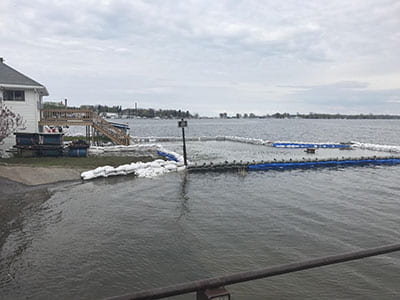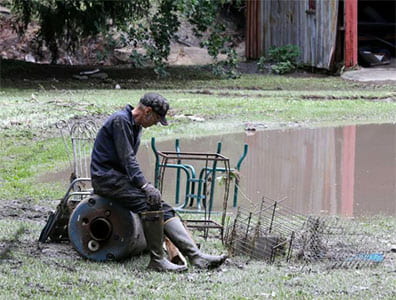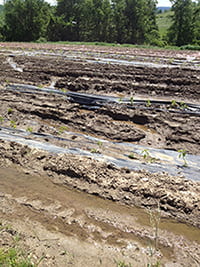
According to the New York State Hazard Mitigation Plan, flooding is defined as, “A temporary condition of partial or complete inundation of water on land that is normally dry.” The plan also notes that flooding is the primary natural hazard in NYS and can impact any corner of the state including inland communities and waterfront communities that are home to 90% of NYS residents. NYS experiences flooding at a rate of 83 flooding episodes per year resulting in $135.7 million in annualized losses.
Flood terms
Flood watch – flooding is possible.
Flood warning – flooding is occurring or will occur soon. If advised by officials to evacuate, do so immediately.
Flash flood warning – unexpected flooding is imminent. Seek higher ground immediately. Two key elements contribute to flash floods:(1) rainfall intensity (2) length of time that it has been raining. Flash floods are the #1 weather-related killer in the United States.
Management tips
Select the titles below to reveal tips for each situation.
Building and property safety and recovery
Chainsaw Safety for Homeowners – New York State Departmnent of Health
Cleaning & Drying & Rebuilding Your Flooded Home (PDF)
Dry out before rebuilding – video tutorials provided by North Dakota State University (NDSU)
Hiring a mold remediation contractor (PDF) – fact sheet produced by Cornell University & Louisiana State University (2007)
Mold and its potential effects on houses (PDF) – fact sheet by Mark Pierce, Extension Associate, Department of Design & Environmental Analysis, Cornell University (2002)
Protect your water after a natural disaster or emergency – guidance for flooded residential wells from the Environmental Protection Agency (EPA)
Recommended excerpts from Texas A&M Agrilife Extension’s After a Disaster Guidebook:
Salvaging Important Papers Books and Photos
Rehabbing Flooded Homes – a guide for builders and contractors involved in the rehabilitation of single-family homes flooded from natural disasters produced by the US Dept. of Housing and Urban Development (HUD) (2008)
Six approaches for preventing flood damage in your home – Louisiana State University (LSU) AG Center
Driving safety
Turn Around Don’t Drown – National Weather Service signage and policy information for driving in flooded areas
Food safety
Emergency Food Worker’s Guide to Food Safety (PDF) – Cornell University Department of Food Science: Assisting communities to plan and properly prepare and serve safe food in an emergency situation (2002)
Flooded Gardens – what to do with fruits and vegetables from a home garden that has been flooded. Food safety is a major concern. (South Dakota State University)
Dealing with a boil water order (PDF) – tip sheet prepared by Cornell Cooperative Extension (2005)
Farm recovery
Disaster Assistance Programs – Farm Service Agency, United States Department of Agriculture
Dealing with Flooded Vegetable Fields (PDF) – Factsheet by Steve Reiners Associate Professor in Horticultural Sciences Cornell University (N.D.)
Hot Hay Alert (PDF) – Cornell Cooperative Extension Cayuga County fact sheet (2006)
Flood Recovery Checklists for Farmsteads (PDF) – North Dakota State University Extension Service (2017)
Health Considerations
Protecting Children’s Environmental Health– resources for protecting children’s health in a variety of settings provided by the Environmental Protection Agency (EPA)
Storm, Flood, and Hurricane Response – health and safety resources for recovery workers provided by the Centers for Disease Control and Prevention (CDC)
Preventing carbon monoxide poisoning – guidance for safely using emergency generators or small gasoline engines during flood clean-up provided by the National Institute for Occupational Safety and Health (NIOSH)
Stream intervention and reconstruction
Guidelines and best practices from NYS Department of Environmental Conservation (DEC):
Post-Flood Stream Reconstruction
Guidelines for Post-Flood Stream Construction (PDF)
Post-Flood Emergency Stream Intervention Training Manual (PDF) – 2014
General guidance
After a Disaster Guidebook – Texas A&M Agrilife Extension
Floods, a preparation guide from Purdue University
Disaster Recovery – NYS Division of Homeland Security and Emergency Services
FloodSmart.gov– National Flood Insurance Program: flood risk assessment tools
NOAA Flood Safety Tips and Resources – National Weather Service: Current flood tips and resources
Historical Flooding Events
2017 Lake Ontario
In spring and summer of 2017 Lake Ontario flooded due to heavy rainfall (International Lake Ontario- St. Lawerence River Board, 2018)
2013 Flash Flooding
The June/July 2013 flash flooding in several NYS counties resulted in soil, high rivers, and tributaries, severe weather, and deteriorating crop conditions
Image 1: Oneida Flooding Summer 2013, photo by NY Executive Chamber; Image 2: the aftermath of a flooded barn; Image 3: Schoharie vegetable field damage; Image 4: Vernon, NY










